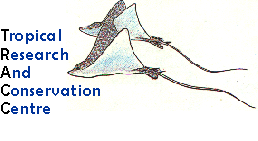|
|
|
|
spawning behaviour and feeding
|
 |
|
|
|
SPAWNING
|
Over the past few years several hundred spawnings have been observed. The male fish arrive before the females and patrol a small spawning aggregation site on the outside of the atoll facing the prevailing current on the edge of the drop-off.
|
|
When the female become receptive she leaves the group and moves upwards and offshore. She is closely followed by the male and after a high speed chase the two fish spawn. Fish of 45 cm and above (both white and green colour phases) were courted and spawned.
A MALE ("SPLIT LIP") AND FEMALE SPAWNING. NOTE THAT THE DOMINANT MALE IS MUCH LARGER THAN THE FEMALE.
|
|
The dominant male spawns with 20-40 females during the day and the interval between spawnings if often less than one minute. Females only spawn once daily but we have yet to determine if they spawn several times during each spawning aggregation.
The males compete aggresively for control of the spawning aggregation and have a strict hierarchy. There are usually 5 or 6 males competing but subdominants rarely spawn with more than one female per day. The dominant males fight for position and are frequently scarred. The alpha male changes frequently with dominant males rarely remaining in top position for a whole year.
During pre-spawning conflicts the males change colour and, if defeated in a territorial dispute chase, the loser rapidly changes colour back to normal.
All the males can be individually identified by shape, scars and other distinguishing marks. Many females can also be identified. |
A MALE ("SCAR FACE", TOP RIGHT) AND HIS HAREM. |
|
|
CONTACT US FOR MORE INFORMATION OR A COPY OF THE PUBLICATION. |
||
|
FEEDING
Humphead wrasse are omnivores which actively search for food for most of
the day. Stones are overturned and inadequately camouflaged prey are
sucked from hiding places. Searching appears to be concentrated in a
home range within which individuals are normally found. However, home
ranges overlap and frequently several individual fish cooperate in
searching for food although feeding is not communal. Cooperative
food searching involved several fish swimming parallel along the reef at a
spacing of 5-6 metres. On several occasions between 3 and 5 fish were seen
searching in this manner. |
THIS FISH HAD JUST DARTED INTO THE TERRITORY OF A TITAN TRIGGERFISH AND STOLEN A MOUTHFUL OF EGGS. |
|HUMPHEAD WRASSE IN SABAH| |HUMPHEAD WRASSE AND THE LIVE FISH TRADE| |POPULATIONS AND SIZES| |NATURAL IDENTIFICATION|

![]()